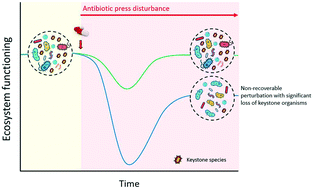Emerging investigator series: activated sludge upon antibiotic shock loading: mechanistic description of functional stability and microbial community dynamics†
Abstract
Elucidating the functional stability upon environmental stressors is of great practical importance for managing the system performance of various environmental biological processes (e.g., activated sludge). This study quantified the dynamic functional stability upon antibiotic ciprofloxacin (CIP) shock loading using three activated sludge microbial communities developed with different carbon sources, i.e., acetate (A), glucose (G), and starch (S). While the press disturbance (5 mg L−1 CIP shock loading) over two months significantly disrupted the heterotrophic activities of the three communities, the extent of the functional stability (i.e., resistance and resilience) was significantly different. The A and G communities exhibited relatively similar magnitudes of resistance (0.52 and 0.58, respectively) and resilience (0.043 and 0.044, respectively), while the S communities with lower initial species richness and diversity were found to be more sensitive (0.27 and 0.02 for resistance and resilience, respectively) to the antibiotic disturbance. 16S rRNA-gene-based community profiling revealed that the severe disruption to the S communities was associated with a significant reduction of a keystone species population (Novosphingobium) capable of hydrolyzing the glycosidic bonds of starch, i.e., the first and rate-limiting step of the overall community catabolism. Our work highlighted the importance of keystone taxa that disproportionately caused a significant impact on the overall ecosystem's function and stability. These results therefore identifying and monitoring keystone taxa would be useful to help prevent poor performance and catastrophic failure of biological treatment processes, which often occur upon shock loads of toxic chemicals.

- This article is part of the themed collection: Emerging Investigator Series


 Please wait while we load your content...
Please wait while we load your content...